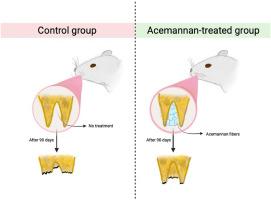The effect of Aloe vera extract application on marginal bone preservation and socket reconstruction after tooth extraction – an animal study
Q1 Medicine
Journal of oral biology and craniofacial research
Pub Date : 2025-09-13
DOI:10.1016/j.jobcr.2025.08.026
引用次数: 0
Abstract
Objectives
Preserving natural teeth is a primary goal in dental treatment, but tooth extraction may be necessary in certain cases. Post-extraction alveolar bone resorption is inevitable, leading to potential complications in implant placement and adjacent teeth. This in-vivo study investigated the effect of Acemannan, an Aloe vera extract, on marginal bone preservation and socket reconstruction following tooth extraction.
Methods
Thirty rats were randomly divided into control and experimental groups. Acemannan extract was placed in the maxillary incisor extraction sockets of the experimental group, while the control group received suturing without additional treatment. Acemannan was extracted from Aloe vera gel using water and absolute ethanol, with extraction efficiency improved via freezer-drying, producing white porous fibers. Bone resorption was monitored in both groups by assessing marginal bone height via CBCT. Follow-up assessments were conducted over 90 days.
Results
No complications were observed in either group during the study. Both groups exhibited significant alveolar bone height reduction post-extraction (P > 0.05). However, the experimental group showed significantly less bone resorption (0.76 ± 0.39 mm) compared to the control group (1.09 ± 0.2 mm) with a P-value of 0.008.
Conclusion
Acemannan placement in extraction sockets may enhance vertical bone preservation and reduce alveolar bone resorption. Aloe vera extract shows promise as a natural, effective agent for promoting bone healing and socket reconstruction post-extraction. Further research is needed to explore its mechanisms and optimize clinical use.

芦荟提取物对拔牙后边缘骨保存和牙槽重建的影响-动物研究
目的保存天然牙齿是牙科治疗的首要目标,但在某些情况下可能需要拔牙。拔牙后牙槽骨吸收是不可避免的,导致种植体放置和邻牙的潜在并发症。这项体内研究调查了芦荟提取物阿西曼南对拔牙后边缘骨保存和牙槽重建的影响。方法30只大鼠随机分为对照组和实验组。实验组在上颌切牙拔牙槽内放置阿塞曼聚糖提取物,对照组在不加治疗的情况下进行缝合。用水和无水乙醇从芦荟凝胶中提取葡甘露聚糖,通过冷冻干燥提高提取效率,得到白色多孔纤维。通过CBCT评估边缘骨高度监测两组骨吸收情况。在90天内进行了后续评估。结果两组患者均无并发症发生。两组拔牙后牙槽骨高度均明显降低(P > 0.05)。但实验组骨吸收(0.76±0.39 mm)明显低于对照组(1.09±0.2 mm), p值为0.008。结论拔牙槽内放置阿塞曼聚糖可增强垂直骨保存,减少牙槽骨吸收。芦荟提取物是一种天然有效的促进骨愈合和骨窝重建的药物。进一步研究其作用机制,优化临床应用。
本文章由计算机程序翻译,如有差异,请以英文原文为准。
求助全文
约1分钟内获得全文
求助全文
来源期刊

Journal of oral biology and craniofacial research
Medicine-Otorhinolaryngology
CiteScore
4.90
自引率
0.00%
发文量
133
审稿时长
167 days
期刊介绍:
Journal of Oral Biology and Craniofacial Research (JOBCR)is the official journal of the Craniofacial Research Foundation (CRF). The journal aims to provide a common platform for both clinical and translational research and to promote interdisciplinary sciences in craniofacial region. JOBCR publishes content that includes diseases, injuries and defects in the head, neck, face, jaws and the hard and soft tissues of the mouth and jaws and face region; diagnosis and medical management of diseases specific to the orofacial tissues and of oral manifestations of systemic diseases; studies on identifying populations at risk of oral disease or in need of specific care, and comparing regional, environmental, social, and access similarities and differences in dental care between populations; diseases of the mouth and related structures like salivary glands, temporomandibular joints, facial muscles and perioral skin; biomedical engineering, tissue engineering and stem cells. The journal publishes reviews, commentaries, peer-reviewed original research articles, short communication, and case reports.
 求助内容:
求助内容: 应助结果提醒方式:
应助结果提醒方式:


